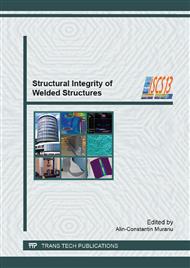p.1
p.7
p.19
p.25
p.33
p.41
p.49
p.54
p.60
Modeling of Heat Transfer in Pipeline Steel Joint Performed by Submerged Double-Arc Welding Procedure
Abstract:
Submerged arc welding is the most applicable and productive procedure when thick sections have to be welded. Nevertheless, the manufacturers of pressure vessels, pipelines, ships and offshore structures keep on looking for new and modern design solutions of equipments and technologies which should lead to increase of welding process productivity. For instance, the longitudinal welds of pipelines are, mostly, performed by submerged arc welding procedure with multiple arcs and/or multi-wires, such as twin, tandem or twin-tandem, in order to increase the process productivity. However, achievement of optimal mechanical properties of the welded joint should remain the most important quality criteria. It is well known that dependence of the mechanical and metallurgical changes on heat transfer plays a major role in obtaining of safe welded structures and preserving of their structural integrity. That is why the investigation of heat transfer induced by the welding process is required. Furthermore, setting of distance between thermal sources and its influence on the overlapping phenomenon of temperature fields should be explored when submerged double-arc welding procedure is applied. Three dimensional finite element model of butt welded joint - used for simulation of heat transfer in pipeline steel joint performed by submerged double-arc welding process - is developed and described in this paper. Numerical results and a comparative analysis related to the temperature distribution, thermal history, and temperature variation in cross section of the welded joint at different time steps are discussed. Finally, important conclusions regarding the influence of distance between thermal sources on thermal effects and temperature fields overlapping are drawn.
Info:
Periodical:
Pages:
33-40
Citation:
Online since:
September 2013
Authors:
Price:
Сopyright:
© 2013 Trans Tech Publications Ltd. All Rights Reserved
Share:
Citation:


